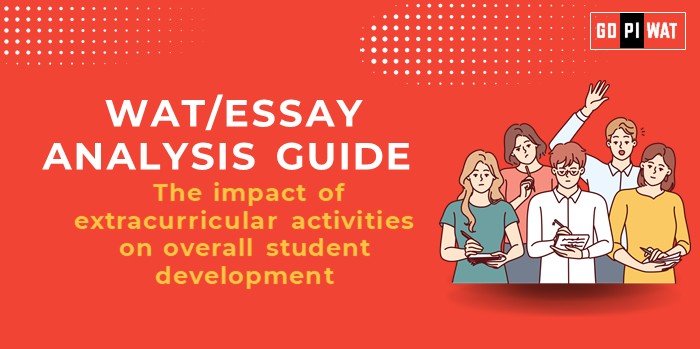📋 The Impact of Extracurricular Activities on Overall Student Development
🌐 Written Ability Test (WAT)/Essay Analysis Guide
💡 Understanding the Topic’s Importance
Context: Extracurricular activities are essential for developing skills beyond academics, aligning with the B-school focus on leadership, team dynamics, and holistic development.
These activities nurture soft skills such as teamwork, leadership, and problem-solving, while also fostering emotional well-being. Recognizing their importance in education builds a strong case for their integration into mainstream curricula.
⏳ Effective Planning and Writing
- 🕒 Time Allocation:
- 📝 Planning: 5 minutes
- ✍️ Writing: 20 minutes
- 🔍 Review: 5 minutes
- 📋 Key Preparation Tips:
- 📊 Highlight impactful statistics to strengthen arguments.
- 🧑🤝🧑 Address diverse stakeholders, including schools, students, and parents.
💬 Introduction Techniques for Essays
- ⚖️ Contrast Approach: “While extracurricular activities significantly boost soft skills, disparities in access question their inclusivity.”
- 📅 Timeline Approach: “From school-level leadership to B-school applications, extracurriculars have played a transformative role over decades, shaping individuals into well-rounded professionals.”
📊 Structuring the Essay Body
🏆 Achievements:
- 📈 Improved Grades: Participation in extracurriculars improves time management, leading to a 10-15% increase in academic performance.
- 🛠️ Skill Development: Activities such as sports and debates enhance teamwork, problem-solving, and leadership abilities.
- 🧠 Mental Well-being: Participation reduces stress, improves emotional resilience, and fosters self-confidence.
⚠️ Challenges:
- 🌍 Access Disparities: Rural and low-income students often lack access to structured extracurricular programs.
- ⏳ Time Management: Balancing academics with activities is challenging, particularly in competitive education systems.
- 📉 Undervaluation: Many schools focus heavily on academics, undervaluing the long-term benefits of extracurricular engagements.
🚀 Future Outlook:
- 🌐 Inclusive Programs: Focus on expanding access through digital platforms and partnerships with NGOs.
- 💻 Technology Integration: Use online platforms to deliver virtual extracurricular programs to underserved regions.
- 📊 Balanced Frameworks: Integrate extracurriculars seamlessly into academic schedules to reduce time conflicts.
✅ Concluding Effectively
- ⚖️ Balanced Approach: “Extracurricular activities are indispensable for student development, fostering skills that go beyond academics. However, bridging gaps in access and ensuring inclusivity remain crucial for maximizing their impact.”
- 🌍 Visionary Approach: “The future of education lies in democratizing access to extracurricular activities, using digital innovations and inclusive policies to empower every student.”
📝 Sample Short Essays
🔹 Balanced Perspective:
“Extracurricular activities are indispensable for student development, fostering leadership, teamwork, and resilience. However, disparities in access and an overemphasis on academics pose significant challenges. Bridging these gaps through inclusive policies and digital platforms can ensure holistic growth for all students.”
🔹 Solution-Oriented:
“By integrating extracurriculars into digital education platforms, we can expand access to students in underserved regions. Partnerships with NGOs and governments can democratize the benefits of extracurricular activities, ensuring every child reaps the rewards of holistic education.”
🔹 Global Comparison:
“Countries like Finland exemplify the success of balanced curricula that integrate academics with arts and sports. India must adopt similar models to ensure equitable access to extracurricular programs, empowering students with skills that are crucial for both personal and professional growth.”
📚 Key Takeaways
- 🎓 Extracurricular activities foster leadership, teamwork, and resilience, enhancing overall development.
- ⚠️ Challenges like access disparities and time management need systemic solutions.
- 🚀 The integration of digital tools and inclusive frameworks can democratize access to extracurricular opportunities.


